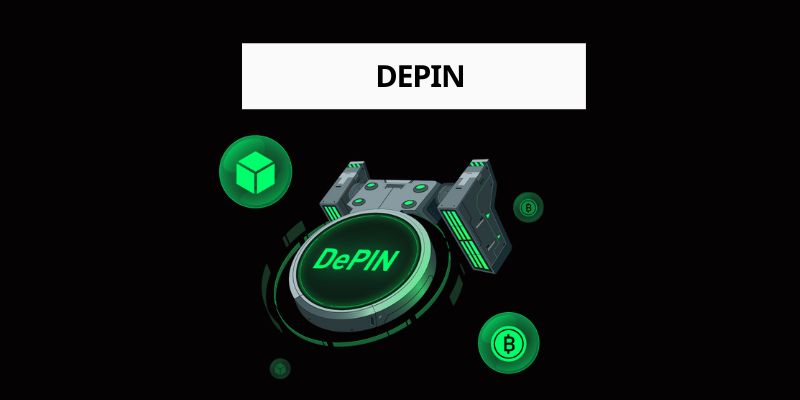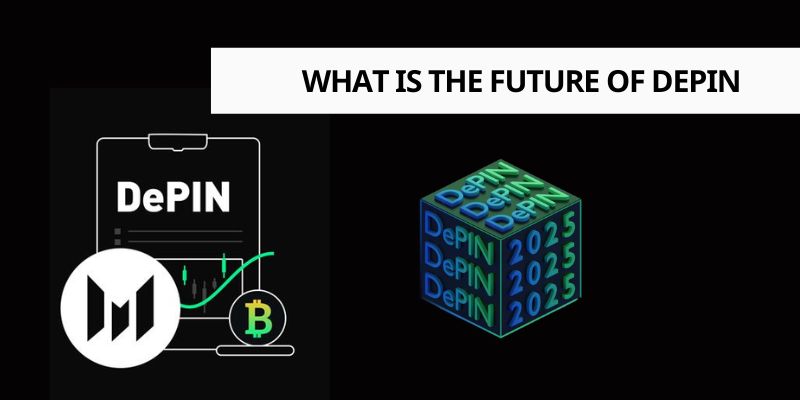Understanding DePIN: A Quick Recap
Before diving into what is the future of DePIN, let’s briefly define it. DePIN refers to Decentralized Physical Infrastructure Networks—blockchain-based systems that incentivize individuals and communities to contribute physical resources, such as WiFi hotspots, data storage, or renewable energy grids.
Unlike traditional centralized models controlled by corporations or governments, DePIN distributes ownership and governance among participants, fostering resilience, efficiency, and inclusivity. Projects like Helium (decentralized wireless networks), Filecoin (decentralized storage), and Arkreen (renewable energy) are already showcasing its real-world potential.
What is the Future of DePIN? Key Trends to Watch
The future of DePIN is bright, driven by technological advancements, growing adoption, and a shift toward decentralized solutions. Here are the top trends shaping what is the future of DePIN:
1. Technological Advancements
The convergence of blockchain, the Internet of Things (IoT), and artificial intelligence (AI) is supercharging DePIN’s capabilities. As blockchain networks become faster and more scalable (e.g., through layer-2 solutions like Caldera or Eclipse), DePIN projects can handle larger volumes of transactions and data. IoT devices, such as sensors and smart hardware, enable real-time monitoring of physical infrastructure, while AI optimizes performance and predicts maintenance needs. This synergy will make DePIN networks more efficient and accessible, answering what is the future of DePIN with a clear focus on innovation.
2. Massive Market Growth
Industry experts predict explosive growth for DePIN. According to Messari, the Total Addressable Market (TAM) for DePIN could reach $3.5 trillion by 2028, with some estimates suggesting it could tap into the $90 trillion non-digital economy. Sectors like telecommunications, energy, and cloud computing—currently dominated by centralized giants like Amazon and Microsoft—are ripe for disruption. What is the future of DePIN? It’s a future where decentralized networks capture significant market share by offering cost-effective, community-driven alternatives.

3. Community-Driven Infrastructure
One of DePIN’s defining features is its bottom-up approach. Instead of relying on hefty corporate investments, DePIN incentivizes individuals to contribute resources—think homeowners installing Helium hotspots or drivers sharing data via DIMO. This grassroots model not only reduces costs but also democratizes access to infrastructure, especially in underserved regions. What is the future of DePIN lies in empowering communities to build and own the networks they rely on.
4. Sustainability and Resilience
As climate change and resource scarcity become pressing concerns, DePIN offers sustainable solutions. Decentralized energy grids, for instance, can integrate renewable sources like solar and wind, enabling peer-to-peer energy trading. Additionally, DePIN’s distributed nature makes it more resilient to disruptions—whether from natural disasters or cyberattacks—compared to centralized systems. What is the future of DePIN? A greener, more robust infrastructure landscape.
5. Integration with Web3 and the Digital Economy
DePIN is a natural extension of Web3, bridging the gap between digital and physical worlds. By integrating with decentralized finance (DeFi) and non-fungible tokens (NFTs), DePIN projects can offer new monetization models, such as tokenized ownership of infrastructure assets. This alignment with Web3’s ethos of openness and decentralization positions DePIN as a key player in the next wave of digital adoption. So, what is the future of DePIN? It’s a vital pillar of the decentralized internet.
Opportunities in the Future of DePIN
The potential applications of DePIN are vast, offering exciting opportunities across industries. Here’s how what is the future of DePIN could unfold:
- Telecommunications: Decentralized 5G or WiFi networks (e.g., Helium) could provide affordable, censorship-resistant connectivity worldwide.
- Energy: Peer-to-peer energy trading on decentralized grids could accelerate the adoption of renewables.
- Data Storage: Projects like Filecoin and Storj could challenge centralized cloud providers by offering secure, cost-effective alternatives.
- Mobility: DePIN solutions like DIMO could revolutionize transportation by monetizing vehicle data and optimizing traffic systems.
- Smart Cities: Sensors and IoT devices in DePIN networks could enhance urban planning, from traffic management to environmental monitoring.
These opportunities highlight what is the future of DePIN: a world where infrastructure is more equitable, efficient, and innovative.

Challenges to Overcome
While the outlook is promising, what is the future of DePIN isn’t without hurdles:
- As networks grow, blockchain transaction speeds and costs must keep pace with demand.
- Uncertain legal frameworks could slow adoption, especially in regulated sectors like telecom and energy.
- Fluctuating token prices might deter participation if rewards become inconsistent.
- Ensuring consistent quality from crowd-sourced hardware remains a challenge.
Addressing these issues will be critical to unlocking what is the future of DePIN and ensuring its long-term success.
Why DePIN Matters for the Future?
So, what is the future of DePIN? It’s a paradigm shift that challenges the status quo of centralized infrastructure. By reducing costs, enhancing resilience, and promoting fairness, DePIN aligns with the growing demand for decentralized, transparent systems. It’s not just a crypto trend—it’s a movement that could redefine how we live, work, and interact with the physical world.
For businesses, entrepreneurs, and communities, DePIN offers a chance to participate in a new economy where infrastructure isn’t controlled by a few but built by many. As adoption accelerates and technology matures, what is the future of DePIN becomes clear: a decentralized, sustainable, and community-centric tomorrow.

